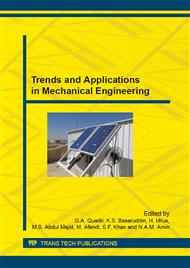[1]
W. Schlickewei and C. Schlickewei, The Use of Bone Substitutes in the Treatment of Bone Defects – the Clinical View and History, Macromolecular Symposia, vol. 253, pp.10-23, (2007).
DOI: 10.1002/masy.200750702
Google Scholar
[2]
J. S. Silber, D. G. Anderson, S. D. Daffner, B. T. Brislin, J. M. Leland, A. S. Hilibrand, A. R. Vaccaro, and T. J. Albert, Donor Site Morbidity After Anterior Iliac Crest Bone Harvest for Single-Level Anterior Cervical Discectomy and Fusion, Spine, vol. 28, pp.134-139, (2003).
DOI: 10.1097/00007632-200301150-00008
Google Scholar
[3]
A. Neamat, A. Gawish, and A. M. Gamal-Eldeen, [beta]-Tricalcium phosphate promotes cell proliferation, osteogenesis and bone regeneration in intrabony defects in dogs, Archives of Oral Biology, vol. 54, pp.1083-1090, (2009).
DOI: 10.1016/j.archoralbio.2009.09.003
Google Scholar
[4]
H. H. Horch, R. Sader, C. Pautke, A. Neff, H. Deppe, and A. Kolk, Synthetic, pure-phase beta-tricalcium phosphate ceramic granules (Cerasorb®) for bone regeneration in the reconstructive surgery of the jaws, International Journal of Oral and Maxillofacial Surgery, vol. 35, pp.708-713, (2006).
DOI: 10.1016/j.ijom.2006.03.017
Google Scholar
[5]
J. P. Schmitz, Bone Substitutes in Reconstructive Implant Surgery, Journal of Oral and Maxillofacial Surgery, vol. 63, pp.117-118, (2005).
DOI: 10.1016/j.joms.2005.05.067
Google Scholar
[6]
C. E. Wilson, J. D. de Bruijn, C. A. van Blitterswijk, A. J. Verbout, and W. J. Dhert, Design and fabrication of standardized hydroxyapatite scaffolds with a defined macro-architecture by rapid prototyping for bone-tissue-engineering research, J. Biomed. Mate. r Res. A, vol. 68, pp.123-132, (2004).
DOI: 10.1002/jbm.a.20015
Google Scholar
[7]
D. W. Hutmacher, Scaffolds in tissue engineering bone and cartilage, Biomaterials, vol. 21, pp.2529-2543, (2000).
DOI: 10.1016/s0142-9612(00)00121-6
Google Scholar
[8]
S. -C. Lee, C. -T. Wu, S. -T. Lee, and P. -J. Chen, Cranioplasty using polymethyl methacrylate prostheses, Journal of Clinical Neuroscience, vol. 16, pp.56-63, (2009).
DOI: 10.1016/j.jocn.2008.04.001
Google Scholar
[9]
S. Lohfeld, P. McHugh, D. Serban, D. Boyle, G. O'Donnell, and N. Peckitt, Engineering Assisted Surgery(TM): A route for digital design and manufacturing of customised maxillofacial implants, Journal of Materials Processing Technology, vol. 183, pp.333-338, (2007).
DOI: 10.1016/j.jmatprotec.2006.10.028
Google Scholar
[10]
P. S. D'Urso, W. J. Earwaker, T. M. Barker, M. J. Redmond, R. G. Thompson, D. J. Effeney, and F. H. Tomlinson, Custom cranioplasty using stereolithography and acrylic, British Journal of Plastic Surgery, vol. 53, pp.200-204, (2000).
DOI: 10.1054/bjps.1999.3268
Google Scholar
[11]
S. Yang, H. Yang, X. Chi, J. R. G. Evans, I. Thompson, R. J. Cook, and P. Robinson, Rapid prototyping of ceramic lattices for hard tissue scaffolds, Materials & Design, vol. 29, pp.1802-1809, (2008).
DOI: 10.1016/j.matdes.2008.03.024
Google Scholar
[12]
E. Bassoli, A. Gatto, L. Iuliano, and M. G. Violante, 3D printing technique applied to rapid casting, Rapid Prototyping Journal, vol. 13, pp.148-155, (2007).
DOI: 10.1108/13552540710750898
Google Scholar
[13]
D. W. Hutmacher, M. Sittinger, and M. V. Risbud, Scaffold-based tissue engineering: rationale for computer-aided design and solid free-form fabrication systems, Trends in Biotechnology, vol. 22, pp.354-362, (2004).
DOI: 10.1016/j.tibtech.2004.05.005
Google Scholar
[14]
P. Wang, J. Hu, and P. X. Ma, The engineering of patient-specific, anatomically shaped, digits, Biomaterials, vol. 30, pp.2735-2740, (2009).
DOI: 10.1016/j.biomaterials.2009.01.037
Google Scholar
[15]
J. Will, R. Melcher, C. Treul, N. Travitzky, U. Kneser, E. Polykandriotis, R. Horch, and P. Greil, Porous ceramic bone scaffolds for vascularized bone tissue regeneration, Journal of Materials Science-Materials in Medicine, vol. 19, pp.2781-2790, Aug (2008).
DOI: 10.1007/s10856-007-3346-5
Google Scholar
[16]
K. Xiao, K. W. Dalgarno, D. J. Wood, R. D. Goodridge, and C. Ohtsuki, Indirect selective laser sintering of apatite–wollostonite glass–ceramic, Proceedings of the Institution of Mechanical Engineers, Part H: Journal of Engineering in Medicine, vol. 222, pp.1107-1114, (2008).
DOI: 10.1243/09544119jeim411
Google Scholar
[17]
K. Xiao, J. A. Dyson, K. W. Dalgarno, P. Genever, D. J. Wood, R. D. Goodridge, and C. Ohtsuki, Manufacture and characterisation of bioceramic tissue engineering scaffolds produced by selective laser sintering, in ASME International Conference on Manufacturing Science and Engineering, Atlanta, GA, 2007, pp.83-90.
DOI: 10.1115/msec2007-31031
Google Scholar
[18]
BSI, BS EN 1389: 2003 Advanced technical ceramics. Ceramic composites. Physical properties. Determination of density and apparent porosity., vol. BS EN 1389: 2003, B. S. Institute, Ed.: Bristish Standard Institute, London, 2003, p.12.
DOI: 10.3403/02984267
Google Scholar
[19]
S. F. Khan, Dalgarno, Kenneth W., Design of customised bioceramic medical implants by layered manufacturing, in Innovative Developments in Design and Manufacturing, P. J. e. a. Bartolo, Ed. London: Taylor & Francis Group, 2010, pp.187-192.
DOI: 10.1201/9780203859476.ch27
Google Scholar
[20]
T. Kokubo, Bioactive glass-ceramics, in Bioceramics and their clinical applications, T. Kokubo, Ed. Cambridge: Woodhead Publishing, 2008, pp.284-301.
DOI: 10.1533/9781845694227.2.284
Google Scholar


